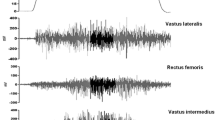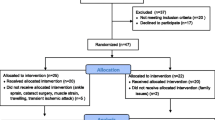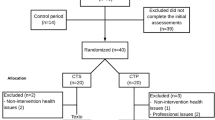Abstract
This study investigated the effects of low- and high-volume strength trainings on neuromuscular adaptations of lower- and upper-body muscles in older women after 6 weeks (6WE), 13 weeks (13WE), and 20 weeks (20WE) of training. Healthy older women were assigned to low-volume (LV) or high-volume (HV) training groups. The LV group performed one set of each exercise, while the HV group performed three sets, 2 days/week. Knee extension and elbow flexion one-repetition maximum (1-RM), maximal isometric strength, maximal muscle activation, and muscle thickness (MT) of the lower- and upper-body muscles, as well as lower-body muscle quality (MQ) obtained by ultrasonography, were evaluated. Knee extension and elbow flexion 1-RM improved at all time points for both groups; however, knee extension 1-RM gains were greater for the HV group after 20WE. Maximal isometric strength of the lower body for both groups increased only at 20WE, while upper-body maximal isometric strength increased after 13WE and 20WE. Maximal activation of the lower and upper body for both groups increased only after 20WE. Both groups showed significant increases in MT of their lower and upper body, with greater gains in lower-body MT for the HV group at 20WE. MQ improved in both groups after 13WE and 20WE, whereas the HV group improved more than the LV group at 20WE. These results showed that low- and high-volume trainings have a similar adaptation time course in the muscular function of upper-body muscles. However, high-volume training appears to be more efficient for lower-body muscles after 20 weeks of training.



Similar content being viewed by others
References
Aagaard P, Suetta C, Caserotti P, Magnusson SP, Kjaer M (2010) Role of the nervous system in sarcopenia and muscle atrophy with aging: strength training as a countermeasure. Scand J Med Sci Sports 20:49–64. doi:10.1111/j.1600-0838.2009.01084.x
American College of Sports Medicine (2009) American College of Sports Medicine position stand. Progression models in resistance training for healthy adults. Med Sci Sports Exerc 41:687–708. doi:10.1249/MSS.0b013e3181915670
Andersen JL (2003) Muscle fibre type adaptation in the elderly human muscle. Scand J Med Sci Sports 13:40–47. doi:10.1034/j.1600-0838.2003.00299.x
Arts IM, Pillen S, Schelhaas HJ, Overeem S, Zwarts MJ (2010) Normal values for quantitative muscle ultrasonography in adults. Muscle Nerve 41:32–41. doi:10.1002/mus.21458
Ashe J (1997) Force and the motor cortex. Behav Brain Res 86:1–15
Babault N, Pousson M, Michaut A, Van Hoecke J (2003) Effect of quadriceps femoris muscle length on neural activation during isometric and concentric contractions. J Appl Physiol 94:983–990. doi:10.1152/japplphysiol.00717.2002
Beneka A, Malliou P, Fatouros I, Jamurtas A, Gioftsidou A, Godolias G, Taxildaris K (2005) Resistance training effects on muscular strength of elderly are related to intensity and gender. J Sci Med Sport 8:274–283. doi:10.1016/S1440-2440(05)80038-6
Berg HE, Tedner B, Tesch PA (1993) Changes in lower limb muscle cross-sectional area and tissue fluid volume after transition from standing to supine. Acta Physiol Scand 148:379–385
Borst SE, De Hoyos DV, Garzarella L, Vincent K, Pollock BH, Lowenthal DT, Pollock ML (2001) Effects of resistance training on insulin-like growth factor-I and IGF binding proteins. Med Sci Sports Exerc 33:648–653
Bottaro M, Veloso J, Wagner D, Gentil P (2011) Resistance training for strength and muscle thickness: effect of number of sets and muscle group trained. Science and sports 26:259–264. doi:10.1016/j.scispo.2010.09.009
Cadore EL, Izquierdo M, Alberton CL, Pinto RS, Conceicão M, Cunha G, Radaelli R, Bottaro M, Trindade GT, Kruel LF (2012) Strength prior to endurance intra-session exercise sequence optimizes neuromuscular and cardiovascular gains in elderly men. Exp Gerontol 47:164–169. doi:10.1016/j.exger.2011.11.013
Caldwell GE, Jamison JC, Lee S (1993) Amplitude and frequency measures of surface electromyography during dual task elbow torque production. Eur J Appl Physiol Occup Physiol 66:349–356
Cannon J, Marino FE (2010) Early-phase neuromuscular adaptations to high- and low-volume resistance training in untrained young and older women. J Sports Sci 28:1505–1514. doi:10.1080/02640414.2010.517544
Carroll TJ, Selvanayagam VS, Riek S, Semmler JG (2011) Neural adaptations to strength training: moving beyond transcranial magnetic stimulation and reflex studies. Acta Physiol (Oxf) 202:119–140. doi:10.1111/j.1748-1716.2011.02271.x
Chilibeck PD, Stride D, Farthing JP, Burke DG (2004) Effect of creatine ingestion after exercise on muscle thickness in males and females. Med Sci Sports Exerc 36:1781–1788. doi:10.1249/01. MSS.0000142301.70419.C6
Cornelison DD, Wold BJ (1997) Single-cell analysis of regulatory gene expression in quiescent and activated mouse skeletal muscle satellite cells. Dev Biol 191:270–283
Deschenes MR, Kraemer WJ (2002) Performance and physiologic adaptations to resistance training. Am J Phys Med Rehabil 81:S3–16. doi:10.1097/01.PHM.0000029722.06777.E9
Duchateau J, Enoka RM (2002) Neural adaptations with chronic activity patterns in able-bodied humans. Am J Phys Med Rehabil 81:S17–27. doi:10.1097/01.PHM.0000029724.14558.BC
Fukumoto Y, Ikezoe T, Yamada Y, Tsukagoshi R, Nakamura M, Mori N, Kimura M, Ichihashi N (2012) Skeletal muscle quality assessed from echo intensity is associated with muscle strength of middle-aged and elderly persons. Eur J Appl Physiol 112:1519–1525. doi:10.1007/s00421-011-2099-5
Galvão DA, Taaffe DR (2005) Resistance exercise dosage in older adults: single- versus multiset effects on physical performance and body composition. J Am Geriatr Soc 53:2090–2097. doi:10.1111/j.1532-5415.2005.00494.x
Goodpaster BH, Krishnaswami S, Resnick H, Kelley DE, Haggerty C, Harris TB, Schwartz AV, Kritchevsky S, Newman AB (2003) Association between regional adipose tissue distribution and both type 2 diabetes and impaired glucose tolerance in elderly men and women. Diabetes Care 26:372–379
Hakkinen K, Komi PV, Alen M, Kauhanen H (1987) EMG, muscle fibre and force production characteristics during a 1 year training period in elite weight-lifters. Eur J Appl Physiol Occup Physiol 56:419–427. doi:10.1007/BF00417769
Hanssen KE, Kvamme NH, Nilsen TS, Ronnestad B, Ambjornsen IK, Norheim F, Kadi F, Hallen J, Drevon CA, Raastad T (2012) The effect of strength training volume on satellite cells, myogenic regulatory factors, and growth factors. Scand J Med Sci Sports. doi:10.1111/j.1600-0838.2012.01452.x
Hass CJ, Garzarella L, de Hoyos D, Pollock ML (2000) Single versus multiple sets in long-term recreational weightlifters. Med Sci Sports Exerc 32:235–242. doi:10.1097/00005768-200001000-00035
Ivey FM, Roth SM, Ferrell RE, Tracy BL, Lemmer JT, Hurlbut DE, Martel GF, Siegel EL, Fozard JL, Jeffrey Metter E, Fleg JL, Hurley BF (2000) Effects of age, gender, and myostatin genotype on the hypertrophic response to heavy resistance strength training. J Gerontol A Biol Sci Med Sci 55:M641–648
Kawakami Y (2005) The effects of strength training on muscle architecture in humans. Int J Sport Health Sci 3:208–217
Korhonen MT, Mero AA, Alen M, Sipila S, Hakkinen K, Liikavainio T, Viitasalo JT, Haverinen MT, Suominen H (2009) Biomechanical and skeletal muscle determinants of maximum running speed with aging. Med Sci Sports Exerc 41:844–856. doi:10.1249/MSS.0b013e3181998366
Kraemer WJ, Ratamess NA (2004) Fundamentals of resistance training: progression and exercise prescription. Med Sci Sports Exerc 36:674–688. doi:10.1249/01.MSS.0000121945.36635.61
Kraemer WJ, Ratamess N, Fry AC, Triplett-McBride T, Koziris LP, Bauer JA, Lynch JM, Fleck SJ (2000) Influence of resistance training volume and periodization on physiological and performance adaptations in collegiate women tennis players. Am J Sports Med 28:626–633
Krieger JW (2010) Single vs. multiple sets of resistance exercise for muscle hypertrophy: a meta-analysis. J Strength Cond Res 24:1150–1159. doi:10.1519/JSC.0b013e3181d4d436
Kumagai K, Abe T, Brechue WF, Ryushi T, Takano S, Mizuno M (2000) Sprint performance is related to muscle fascicle length in male 100-m sprinters. J Appl Physiol 88:811–816. doi:10.1111/j.1600-0838.2012.01452.x
Macefield VG, Fuglevand AJ, Bigland-Ritchie B (1996) Contractile properties of single motor units in human toe extensors assessed by intraneural motor axon stimulation. J Neurophysiol 75:2509–2519
Marx JO, Ratamess NA, Nindl BC, Gotshalk LA, Volek JS, Dohi K, Bush JA, Gomez AL, Mazzetti SA, Fleck SJ, Hakkinen K, Newton RU, Kraemer WJ (2001) Low-volume circuit versus high-volume periodized resistance training in women. Med Sci Sports Exerc 33:635–643. doi:10.1097/00005768-200104000-00019
McBride JM, Blaak JB, Triplett-McBride T (2003) Effect of resistance exercise volume and complexity on EMG, strength, and regional body composition. Eur J Appl Physiol 90:626–632. doi:10.1007/s00421-003-0930-3
Miyatani M, Kanehisa H, Kuno S, Nishijima T, Fukunaga T (2002) Validity of ultrasonograph muscle thickness measurements for estimating muscle volume of knee extensors in humans. Eur J Appl Physiol 86:203–208. doi:10.1007/s00421-001-0533-9
Nakazawa K, Kawakami Y, Fukunaga T, Yano H, Miyashita M (1993) Differences in activation patterns in elbow flexor muscles during isometric, concentric and eccentric contractions. Eur J Appl Physiol Occup Physiol 66:214–220. doi:10.1007/BF00235096
Narici MV, Roi GS, Landoni L, Minetti AE, Cerretelli P (1989) Changes in force, cross-sectional area and neural activation during strength training and detraining of the human quadriceps. Eur J Appl Physiol Occup Physiol 59:310–319
Narici MV, Maganaris C, Reeves N (2005) Myotendinous alterations and effects of resistive loading in old age. Scand J Med Sci Sports 15:392–401. doi:10.1111/j.1600-0838.2005.00458.x
Ogawa K, Sanada K, Machida S, Okutsu M, Suzuki K (2010) Resistance exercise training-induced muscle hypertrophy was associated with reduction of inflammatory markers in elderly women. Mediators Inflamm. doi:10.1155/2010/171023
Paulsen G, Myklestad D, Raastad T (2003) The influence of volume of exercise on early adaptations to strength training. J Strength Cond Res 17:115–120
Peterson MD, Pistilli E, Haff GG, Hoffman EP, Gordon PM (2011) Progression of volume load and muscular adaptation during resistance exercise. Eur J Appl Physiol 111:1063–1071. doi:10.1007/s00421-010-1735-9
Pincivero DM, Gandhi V, Timmons MK, Coelho AJ (2006) Quadriceps femoris electromyogram during concentric, isometric and eccentric phases of fatiguing dynamic knee extensions. J Biomech 39:246–254. doi:10.1016/j.jbiomech.2004.11.023
Radaelli R, Botton CE, Wilhelm EN, Bottaro M, Lacerda F, Gaya A, Moraes K, Peruzzolo A, Brown LE, Pinto RS (2013) Low- and high-volume strength training induces similar neuromuscular improvements in muscle quality in elderly women. Exp Gerontol 48:710–716. doi:10.1016/j.exger.2013.04.003
Reimers CD, Fleckenstein JL, Witt TN, Muller-Felber W, Pongratz DE (1993) Muscular ultrasound in idiopathic inflammatory myopathies of adults. J Neurol Sci 116:82–92
Rhea MR, Alvar BA, Burkett LN, Ball SD (2003) A meta-analysis to determine the dose response for strength development. Med Sci Sports Exerc 35:456–464. doi:10.1249/01.MSS.0000053727.63505.D4
Ronnestad BR, Egeland W, Kvamme NH, Refsnes PE, Kadi F, Raastad T (2007) Dissimilar effects of one- and three-set strength training on strength and muscle mass gains in upper and lower body in untrained subjects. J Strength Cond Res 21:157–163. doi:10.1519/R-19895.1
Schoenfeld BJ (2010) The mechanisms of muscle hypertrophy and their application to resistance training. J Strength Cond Res 24:2857–2872. doi:10.1519/JSC.0b013e3181e840f3
Sipilä S, Suominen H (1994) Knee extension strength and walking speed in relation to quadriceps muscle composition and training in elderly women. Clin Physiol 14:433–442
Visser M, Goodpaster BH, Kritchevsky SB, Newman AB, Nevitt M, Rubin SM, Simonsick EM, Harris TB (2005) Muscle mass, muscle strength, and muscle fat infiltration as predictors of incident mobility limitations in well-functioning older persons. J Gerontol A Biol Sci Med Sci 60:324–333. doi:10.1093/gerona/60.3.324
Wei Y, Chen K, Whaley-Connell AT, Stump CS, Ibdah JA, Sowers JR (2008) Skeletal muscle insulin resistance: role of inflammatory cytokines and reactive oxygen species. Am J Physiol Regul Integr Comp Physiol 294:R673–680. doi:10.1152/ajpregu.00561.2007
Acknowledgments
We would like to acknowledge the CNPq, CAPES, and Miotec-Equipamentos Biomédicos for their funding support for this study.
Author information
Authors and Affiliations
Corresponding author
About this article
Cite this article
Radaelli, R., Botton, C.E., Wilhelm, E.N. et al. Time course of low- and high-volume strength training on neuromuscular adaptations and muscle quality in older women. AGE 36, 881–892 (2014). https://doi.org/10.1007/s11357-013-9611-2
Received:
Accepted:
Published:
Issue Date:
DOI: https://doi.org/10.1007/s11357-013-9611-2




